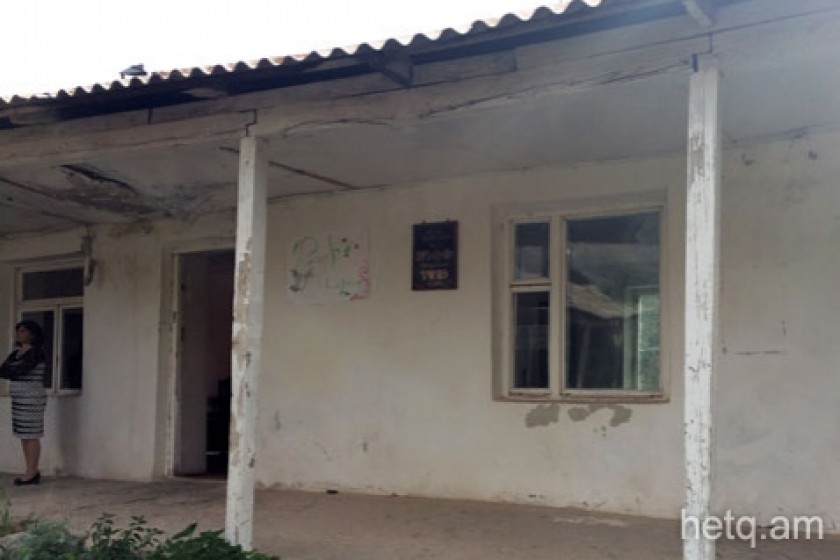
Uncertain Future: Border Village School Has Only Three Pupils; All from the Same Family
Standing outside this nondescript whitewashed one story building in the middle of the village in Arevis, one would be hard pressed to make out that it’s the school if it were not for the plaque and welcome sign attached to the wall.
Our arrival on September 1, the start of the new school year, elicited a number of curious stares from residents milling outside the school. It would appear that unfamiliar cars and visitors are seldom seen in Arevis.
To be honest, we didn’t see any other cars along the road leading to the Arevis, a tiny hamlet in Armenia’s southern Syunik Province. It’s the last stop on the 21 kilometer road that branches away from Sisian. Further afield are the Monastery of Tanahat and then, the border with Nakhijevan.
At the school entrance, I met up with the Principal Rita Grigoryan, who was all smiles and decked out in her holiday finery to welcome her young charges on opening day. Joining her were a teacher and two grannies.
But no pupils ever showed up for class. Principal Grigoryan was flustered.
In point of fact, the school only has three pupils; all sisters from the same family. There’s Merita (3rd grade), Manoushak (3rd grade) and Erna (7th grade).
It turns out that two days ago the sisters went with their parents to Sisian to buy clothes and other school supplies and hadn’t returned.
The principal showed me the two classrooms that had been spruced up for opening day. “We’re a school that’s dependent on one family,” she said. “They’ll come tomorrow and classes will begin.”

At an elevation of 1,950 meters above sea level, Arevis was repopulated by Armenians from Sisian after the local Azeris left during the early 1990 war years. The environment is conducive for animal husbandry and bee-keeping. In a short time the population rose to 150.
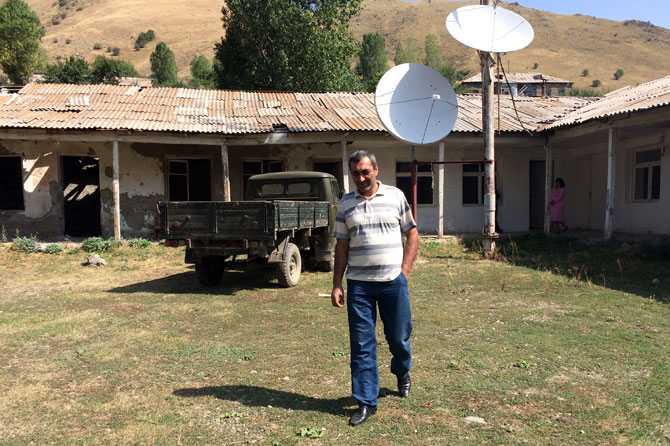 Village Mayor Sasoun Sahakyan told me that despite the favorable conditions for independently living off the land, many newcomers couldn’t acclimate to their new home and gradually left. There’s the distance to travel over poor roads and the lack of adequate transportation to get goods to market for sale. “You saw the road. A car can be swallowed up by one of those potholes.
Village Mayor Sasoun Sahakyan told me that despite the favorable conditions for independently living off the land, many newcomers couldn’t acclimate to their new home and gradually left. There’s the distance to travel over poor roads and the lack of adequate transportation to get goods to market for sale. “You saw the road. A car can be swallowed up by one of those potholes.
| Mayor Sasoun Sahakyan |
People pinned their hopes on mining,” the mayor said, adding that a few years ago Global Gold Mining started exploratory operations in the area that created a number of jobs.
“Later on, the work abruptly stopped for reasons unknown. Five or six young families soon packed their bags and left the village,” he said.
Today, the population of Arevis has dropped to 54 permanent residents; 18 families in total. And it’s an aging population. The mayor told me that there hasn’t been a birth in the last four or five years. There’s just the one pre-school age child, also from the same family as the three sisters mentioned above.
If this family decides to move, the village school would have to close. It’s a constant concern that nags Principal Grigoryan every September 1.
Not surprisingly, it was Grigoryan who convinced this family to move to the village from Sisian two years ago. The mother of the school’s only three pupils now works at the school herself. Principal Grigoryan believes that the village couldn’t exist without a functioning school.
 |
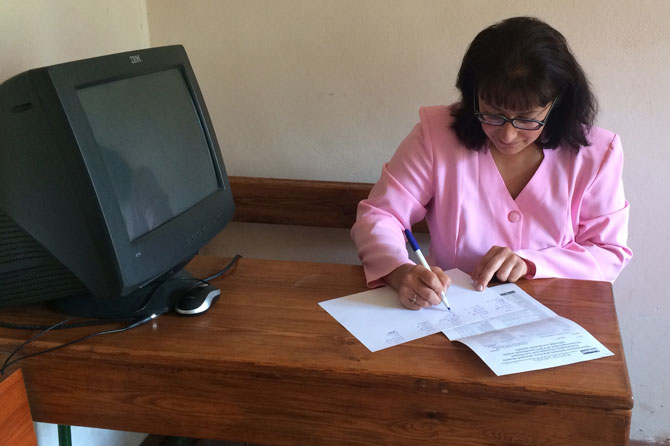 |
| School Principal Rita Grigoryan Teacher Gayaneh Arakelyan |
Grigoryan herself moved to Arevis from Sisian in 1998. She first worked as a teacher and has been serving as principal since 2004.
When she started out, the school’s enrollment was 22. Her salary back then was a mere 6,000 AMD (US$14.59 at today’s exchange rate). Payment was often months late. She stayed nevertheless. Her two children attended the village school and then went off to college.
“There’s a lack of government care,” she lamented. “If it continues like this we’ll end up with empty villages. Local residents are apathetic and won’t even repair their homes. The mentality is the same. We are all temporary residents here.”
Principal Grigoryan sometimes thinks about leaving. On several occasions, she hasn’t even replied to the vacancy announcement for a new principal when her contract has expired. But no one else wants the job so she’s stayed on.
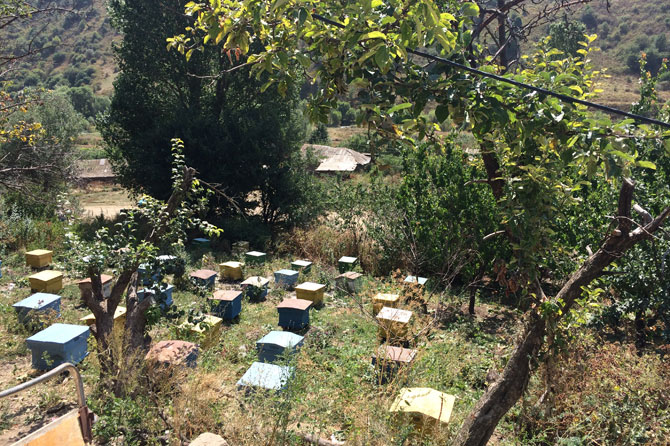
What lifted her spirits was when Armenia’s defense minister visited a nearby military outpost last year. Passing through Arevis, the minister stopped and asked, “Is there a school in the village?”
“I never felt so proud of my work here. I realized that this border village really needs me,” said Grigoryan.
For a school with only three pupils, it has a staff of ten. Only two are teachers. One is the principal herself.
Mayor Sahakyan, at the job for the past twelve years, says that an aging population has left the village without adequate manpower to cultivate the 115 hectares of arable land. Last year, only thirty hectares were cultivated; all by the mayor.
The village budget is four million AMD, just even for a staff of four. The municipal office is located in two rooms at the school.
Despite the abundance of mountain springs in the area, Arevis residents are supplied with poor quality water. The supply pipes have all deteriorated.
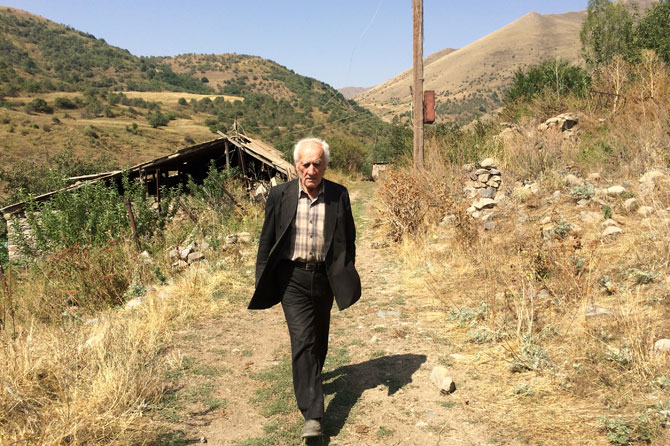
Along a village path I meet up with 80 year-old Sergey Sahakyan, the last mayor of the village during the Soviet era. Sergey had just let his turkeys out from their pen.
“It’s a great village with a rich natural environment. But’s it been neglected,” he says.
The senior citizen then waxes philosophically: “Government is like an organism. It starts dying at the extremities. This country isn’t just Yerevan. There must be villages for the nation to be strong.”
 Videos
Videos Photos
Photos




Write a comment